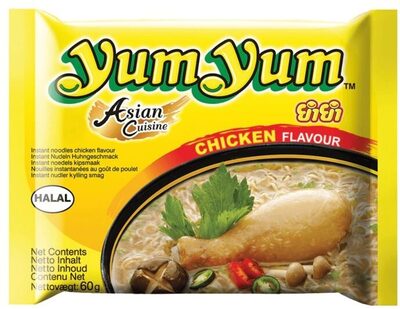Chicken Flavour - YumYum - 60g
Barcode: 8852018101024 (EAN / EAN-13)
Common name: Instant noodles chicken flavour
Quantity: 60g
Packaging: Plastic, PP 5 - Polypropylene
Categories: Plant-based foods and beverages, Plant-based foods, Cereals and potatoes, Cereals and their products, Meals, Dried products, Pastas, Dried products to be rehydrated, Noodles, Soups, Dried meals, Instant noodles, Dehydrated soups, Instant noodle soups, Dehydrated Asian-style soup with noodles
Labels, certifications, awards:
Sustainable, Halal, Sustainable Palm Oil, Roundtable on Sustainable Palm Oil, Triman


Origin of ingredients: Thailand
Manufacturing or processing places: Thailand
Link to the product page on the official site of the producer: https://www.yumyumfoods.com/en/product/p...
Stores: Edeka, Irma.dk, Kaufland, carrefour.fr, Rewe, Go Asia
Countries where sold: Czech Republic, Denmark, France, Germany
Matching with your preferences
Report a problem
Data sources
Product added on by bitnapper
Last edit of product page on by chevalstar.
Product page also edited by ando, anticedros, autorotate-bot, beniben, charlesnepote, date-limite-app, driveoff, ecoscore-impact-estimator, eddisch, einkrankertyp, feat, focccus, foodless, foodvisor, gourmet, halal-app-chakib, hlavackovec, inf, jaschadsa-web-de, keena, kiliweb, kyoopy, mathias, mrhalal, odinh, openfoodfacts-contributors, packbot, predatorix, prepperapp, professordoc, pschonmann, quentinbrd, roboto-app, rochus, scanbot, sympel, tacinte, tacite-mass-editor, versgui, worldtest, yabr, yoxo, yuka.R0lKUUlQNFRtZU13dmRnTzlUU0szSUpwOTUrbVRFMlpCZW9PSVE9PQ, yuka.SDRBck52dzV0dVFNdXZBRzN5UHpvZnhiKzQ2N1JFeUZLZkFmSWc9PQ, yuka.U2ZnWUtiWVpudkJRdWNOaTBVbVBwczliNFlDR2YwaXJBdFE4SVE9PQ, yuka.UmFva0lLWWQrdk1yeXN3d29RL055dGxvbXFDdmQxMklkT3NKSVE9PQ, yuka.V0lVZ05yNVlvL1lUby9JQStEai8yTlp0bmJHTkExeStHK1VzSVE9PQ, yuka.WDU4N0hab1o5OTBUeE1JRXdEcUYzZGhQMnJYMGVtbWFNckpKSUE9PQ, yuka.WUtzQlM0UUNxZGhXeGNjRzRrckw0Yzkzd01HMmVuUG5PY1FCSWc9PQ, yuka.ZG9ZaUZhSU05OE1YaHZKajBDM284UHNxNHEyYlhYR1RKKzFBSUE9PQ, yuka.ZXI0Q0Nmc3hwT2NzcE5vTTRSeU1vL0ovekxtTWZHV2RDc1EwSVE9PQ, yuka.Zm8wa0tLOWN2TlV5cGM4SDlDR08rZkp6MjZlWkJrR3VLL2dTSVE9PQ, yukafix, zebul0n.












